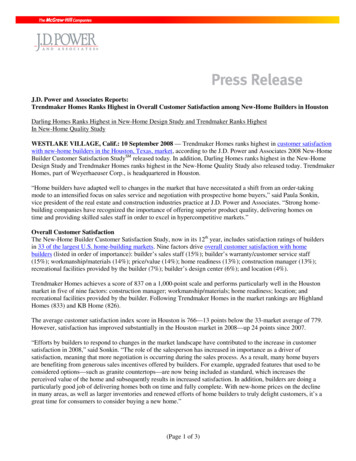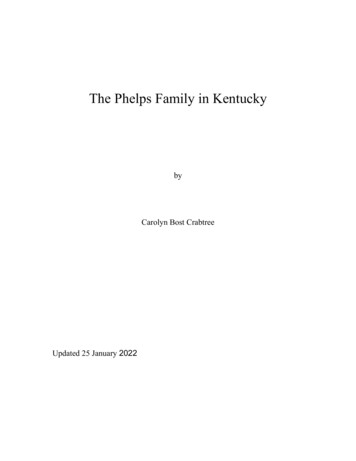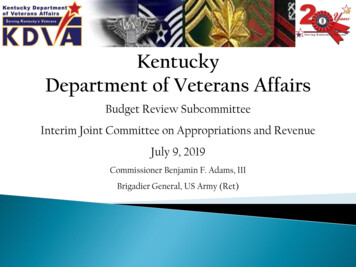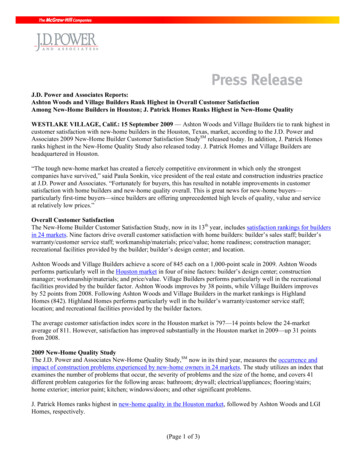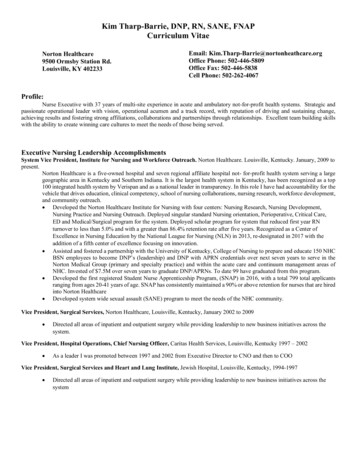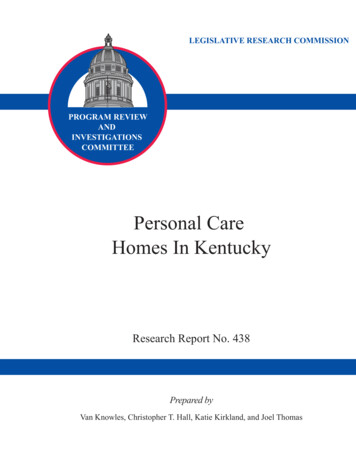
Transcription
LEGISLATIVE RESEARCH COMMISSIONPROGRAM REVIEWANDINVESTIGATIONSCOMMITTEEPersonal CareHomes In KentuckyResearch Report No. 438Prepared byVan Knowles, Christopher T. Hall, Katie Kirkland, and Joel Thomas
Personal Care Homes In KentuckyProgram Review and Investigations CommitteeSen. Jimmy Higdon, Co-chairRep. Fitz Steele, Co-chairSen. Tom BufordSen. Perry B. ClarkSen. Vernie McGahaSen. Joey PendletonSen. Dan “Malano” SeumSen. Brandon SmithSen. Katie Kratz StineRep. Dwight D. ButlerRep. Leslie CombsRep. Jim DeCesareRep. Terry MillsRep. Ruth Ann PalumboRep. Rick RandRep. Arnold SimpsonProject StaffVan KnowlesChristopher T. HallKatie KirklandJoel ThomasGreg Hager, PhDCommittee Staff AdministratorResearch Report No. 438Legislative Research CommissionFrankfort, Kentuckylrc.ky.govAdopted December 13, 2012Paid for with state funds. Available in alternative format by request.
AbstractPersonal care homes are facilities for aged or invalid persons who do not require the intensivecare normally provided in a hospital or nursing home but who do require care in excess of room,board, and laundry. As of September 2012, there were 81 personal care homes in Kentucky. Thisstudy focused on 50 facilities that serve low-income groups who receive public assistance in theform of state supplementation payments. These supplement personal care homes currently house2,361 residents, most of whom have severe and persistent mental illness. This report addresseshow personal care homes operate and the services they provide, payments by residents, stateoversight, and alternatives to personal care homes. This report makes nine recommendations tothe Cabinet for Health and Family Services.
Legislative Research CommissionProgram Review And InvestigationsForewordForewordProgram Review staff thank the numerous officials and staff of the Cabinet for Health andFamily Services who assisted with this study, especially those in the Office of the Secretary;Office of Inspector General; Department for Community Based Services; Department forBehavioral Health, Developmental and Intellectual Disabilities; Department for Aging andIndependent Living; State Long-Term Care Ombudsman; Department for Medicaid Services;and Office of Health Policy. The Kentucky Housing Corporation, Kentucky Protection andAdvocacy, Kentucky Board of Nursing, Kentucky Department of Veterans Affairs, Office of theAttorney General, and Administrative Office of the Courts provided valuable assistance, as didthe federal Department of Veterans Affairs and Social Security Administration.Staff also thank the officials of the Kentucky Association of Health Care Facilities for theirassistance. Staff particularly acknowledge the administrators and owners of personal care homeswho received unannounced visits, many of whom later discussed personal care home issues atlength. Seven Counties, Wellspring, and New Beginnings provided valuable information abouttheir alternatives to personal care homes.LeadingAge Kentucky, Kentucky Association of Regional Mental Health and MentalRetardation Programs, Kentucky Community and Technical College System, Brain InjuryAlliance of Kentucky, Advocates for Community Options, Pam Teaster of the University ofKentucky, and Robert McClelland also provided important background information for thestudy.At the Legislative Research Commission, Alice Lyon compiled legal information and the ProjectCenter and the Office of Legislative Economic Analysis assisted with the personal care homesurvey and other aspects of the study.Robert ShermanDirectorLegislative Research CommissionFrankfort, KentuckyDecember 2012i
Legislative Research CommissionProgram Review And InvestigationsContentsContentsSummary . viiChapter 1: Personal Care Homes In Kentucky .1Personal Care Homes In The Spectrum Of Services .1Personal Care Within Long-Term Care Facilities .2Freestanding Personal Care Homes .2Private-Pay Personal Care Homes .3State Supplement Personal Care Homes .3Study Procedures And Conclusions .4Major Conclusions .5Spectrum Of Living Arrangements By Type Of Need .6Elderly Residents .7Residents With Intellectual And Developmental Disabilities .8Residents With Severe And Persistent Mental Illness .8Residents With Acquired Brain Injuries .9Observations Of Living Conditions .10Private-Pay Personal Care Homes .10Supplement Personal Care Homes .10Chapter 2: Finances Of Personal Care Homes And Residents .13Costs Of Living In Personal Care Homes .14Private-Pay Personal Care Home Rates .14State Supplement Personal Care Home Rates .14Methods Of Payment .14Private Payment Sources.14Public Assistance .15Supplemental Security Income .15Social Security .15State Supplementation .15State Supplementation Recipients And Payments .16History Of State Supplementation Amounts.17Mental Illness Or Mental Retardation Supplement Program.18Donations .19Guardianship .20Medicaid And Personal Care Homes .20Medicaid Costs For Residents .21Kentucky’s Costs Associated With PCH Residents .22Costs To Operate A PCH .24Recommendation 2.1 .25Costs Paid By Personal Care Home Residents .26Personal Expenses .26Health And Behavioral Health Services—Supplement Recipients .26Institutions For Mental Diseases.27Medicare With Medicaid .27iii
ContentsLegislative Research CommissionProgram Review And InvestigationsRecommendation 2.2 .28Health And Behavioral Health Services—Private-Pay Residents .28Medicaid Spend Down .28Medicare Alone .28Chapter 3: Personal Care Home Operations .31Where Residents Come From .31Locations Of PCHs .31Personal Care Services .34Medical Orders.35Health Services In Personal Care Homes .35Personal Care Homes And Other Residential Settings .36Permitted Health Services .36Medication Administration .38Recommendation 3.1 .41Hospice Care .41Recommendation 3.2 .42Behavioral Health Services .42No Treatment By Personal Care Home Staff .42Mental Illness Or Mental Retardation Supplement Program.44Care Planning For SPMI .45Treatment Options In The Community .45Crowding At Personal Care Homes .46Staffing At Personal Care Homes .47Staffing Regulations.47Staffing In Practice .48Expectations Of Personal Care Homes .49Recommendation 3.3 .49Recommendation 3.4 .50Appropriateness Of Personal Care Homes .50Responsibility For Resident Safety .51Restrictions Imposed By Guardians.54Admission Procedures And Screening.54Screening Out Likely Inappropriate Placement .55Recommendation 3.5 .57Recommendation 3.6 .57Discharge And Transfer Procedures .58Chapter 4: State Involvement With Personal Care Homes .61Summary Of Oversight Agencies .61Cabinet For Health And Family Services .61Other State Agencies.62Office Of Inspector General.62Violations And Deficiencies .63Relicensure Surveys .64Disputing Deficiencies And Violations .66iv
Legislative Research CommissionProgram Review And InvestigationsContentsRegulatory Variances .66Investigation Of PCH Complaints .68Records Of Complaints And Relicensure Surveys .71Revoking PCH Licenses .72Seeking Injunctive Relief .73Summary Of Licensure Oversight .73Recommendation 4.1 .74Department For Community Based Services .74Adult Protection Branch .74Investigations .74Semiannual Assessments .74Division Of Family Support.75State Supplement .75MI/MR Program.75Department For Aging And Independent Living .75Guardianship Branch .75State Long-Term Care Ombudsman .76Chapter 5: Alternatives To Personal Care Homes .79Deinstitutionalization And The Olmstead Decision .79Legal Requirements For Community Supports .80Supportive Services In The Community .81Medicaid Coverage For Community Based Services .81A Community Model For Intensive Behavioral Health Services .82Rural Barriers To Assertive Community Treatment .83Paying Shelter Expenses .83Examples Of Community Services In Kentucky .85Center For Rehabilitation And Recovery .85Wellspring .85New Beginnings .86A Different Spectrum Of Services .86Appendix A:Appendix B:Appendix C:Appendix D:Appendix E:Appendix F:How This Study Was Conducted .89State Supplementation Payment Standards .93Kentucky Medicaid Waiver Programs .95State And Local Agencies Related To Personal Care Homes .99Kentucky Laws And Regulations Related To Personal Care Homes .103Personal Care Home Survey .111Endnotes.113v
ContentsLegislative Research CommissionProgram Review And 4.24.3Comparison Of Personal Care Homes To Other Types Of Facilities .2Capacity And Usage Of Personal Care Homes By Type .4Percentage Of Resident Groups By Type Of Personal Care Home .7State Supplementation Recipients In Personal Care Homes By EligibilityFactor, June 2012 .16State Supplementation Payments To Recipients In Personal Care Homes ByEligibility Factor, June 2012 .17Personal Care Home Medicaid Recipient Service Utilization, Most FrequentlyUsed Categories Of Service, FY 2011 .22Costs To The State Related To Personal Care Homes, FY 2011.23Median Costs For Various Types Of Long-Term Health Care In Kentucky, 2012.24Example Of Personal Care Home Operating Costs, 2011 .25Findings Of All Relicensure Surveys Conducted From July 2008 ToJune 2012 At 86 Freestanding PCHs .65Number And Percentage Of Personal Care Homes With Deficiencies Or CitationsDuring Relicensure Surveys, July 2008 To June 2012 .66Most Common Variances To 902 KAR 20:031 .67Figures2.A3.A3.B4.AState Supplementation Payment Standards For Personal Care Homes,1972 To 2012 .18Locations Of Private-Pay Personal Care Homes And Population Density.32Locations And Total Capacity Of Supplement Personal Care Homes AndPopulation Density .33Percentage Of OIG Complaint Investigations Initiated Within The Agency’sTarget Dates By Priority Level And Year, July 2008 To June 2012 .70vi
Legislative Research CommissionProgram Review And InvestigationsSummarySummaryOn August 4, 2011, Joseph Larry Lee Jr. left a personal care home (PCH) without telling thestaff. He had an acquired brain injury and schizophrenia. Four weeks later, Lee’s remains werefound. This case and others raised questions about the safety of PCH residents and theappropriateness of PCHs for residents with certain needs.The Cabinet for Health and Family Services’ Office of Inspector General issues PCH licenses totypical freestanding facilities and to some nursing homes and other facilities with personal carebeds. This report covers freestanding PCHs, which can be divided roughly into two groups: thosethat serve primarily elderly people with private resources and those that serve a variety of lowincome groups that receive public assistance in the form of state supplementation payments.Private-pay PCHs are clustered in Kentucky’s three main population centers. Most PCHs,including the one where Lee stayed, are supplement PCHs, which are mostly in rural areas. Thisreport focuses on supplement PCHs.There were 81 freestanding PCHs in Kentucky as of September 2012, 50 of them supplementPCHs. There were 4,387 usable beds (2,660 in supplement PCHs) and 3,777 residents (2,361 insupplement PCHs). The estimated average cost to the state to support supplement recipients inPCHs is 9,600 per year. This includes the state supplement itself, the state portion of Medicaidservices provided to recipients, and state support for three specialized mental health PCHs.The main group that supplement PCHs serve is people with severe and persistent mental illness.People in this group are considered to have a disability and receive federal disability payments aswell as the state supplement. Another group is people with intellectual or developmentaldisabilities, who also receive disability assistance and state supplementation. Other supplementPCH residents are elderly people who receive federal assistance and state supplementation.Supplement PCHs have a few low-income private-pay residents.The differences between private-pay PCHs and supplement PCHs are dramatic. Private-payPCHs typically charge 2,500 to 4,000 per month, averaging 3,330. PCHs have to accept only 1,158 from residents receiving state supplementation, so private-pay PCHs do not have anysupplement recipients. Private-pay PCHs usually offer private rooms and often offer smallapartments; bathrooms are either private or shared between two rooms. Supplement PCHs offerrooms for double, triple, or quadruple occupancy; bathrooms and showers are almost alwaysshared for an entire hall, wing, or floor. The private-pay PCHs that Program Review staff visitedwere relatively new, spacious, well appointed, and designed for providing personal care services.The visited supplement PCHs were in older buildings, most of them originally motels, schools,offices, or other facilities not designed for health services. The two types of PCH differedsignificantly in the variety and quality of food, appearance of the residents, cleanliness, andactivities.In the current system of care, according to many PCH administrators, ombudsmen, and others,the only alternative for many supplement PCH residents is homelessness, interrupted from timevii
SummaryLegislative Research CommissionProgram Review And Investigationsto time by involuntary hospitalization or time in jail. Nevertheless, there are opportunities forimprovement in the facilities and practices of supplement PCHs.Supplement PCH administrators cited the low reimbursement rate as the major reason for thesometimes unsatisfactory conditions in their facilities. The state has the option of increasing therate, and the cabinet reported that it had requested increased funding. More information about thefinances of PCHs would be useful for making funding decisions.Recommendation 2.1The Cabinet for Health and Family Services should propose a state supplementationrate-setting process that would involve a periodic financial audit of personal care homesaccepting state supplementation recipients. The cabinet should present the proposal,including its projected costs, to the Program Review and Investigations Committee byOctober 1, 2013.State supplementation recipients receive 60 monthly for personal needs including clothing,transportation, off-site entertainment, soft drinks, tobacco, and anything else the resident wantsto buy. The recipient also has to pay any debts or expenses, including copayments for medicalservices and prescriptions. Most recipients receive Medicaid, which covers most health andbehavioral health services. Some PCH residents receive both Medicaid and Medicare; theseresidents have to pay small prescription copayments that might consume much of theirallowance. If residents have insufficient funds to pay for all needed items, PCHs have todischarge them or agree to pay their excess expenses out of PCH funds.Recommendation 2.2The Cabinet for Health and Family Services should propose a method for setting thepersonal needs allowance for state supplementation recipients based on a periodicassessment of personal expenses. The cabinet should present the proposal, including itsprojected costs, to the Program Review and Investigations Committee by October 1, 2013.Personal care services include some assistance with activities of daily living such as feeding,bathing, and grooming oneself; dressing and undressing; and toileting. PCHs perform some dailytasks for their residents, such as cooking, cleaning, laundry, and assistance with medications.PCHs are required to provide basic hygiene supplies.PCHs are licensed health facilities and, when nurses are available, may provide limited healthservices under medical orders. Program Review staff determined that if a PCH has no nurses, itmay keep the residents’ medications in a central, secure location and assist with selfadministration of medications but may not administer them or provide any other health services.There have been discussions among the PCHs, the cabinet, and the Kentucky Board of Nursingabout what services are appropriate for PCHs to provide, but the regulations are not explicit.Regulations mention a “certified medication technician,” but there is no regulatory definition ofsuch a title. Regardless of the title, such staff would be able to provide health services only underthe delegation and supervision of a nurse.viii
Legislative Research CommissionProgram Review And InvestigationsSummaryRecommendation 3.1The Cabinet for Health and Family Services, through regulation or written guidancereferenced in regulation, should clarify the health services that personal care homes may provide, including what staffmay do when there is or is not a nurse to delegate nursing tasks, consistent with nursinglaws and practice, and uniformly define the title, education, and certification requirements for certifiedmedication aides in personal care homes and other long-term care facilities.Some private-pay PCH administrators reported that regulations made it difficult to keep residentswho were dying with hospice care, even when the residents and their families would prefer forthe residents to remain at the PCH until death. The cabinet at this time has no specific regulationor policy on this matter.Recommendation 3.2The Cabinet for Health and Family Services should consider specifying how personal carehome residents who receive hospice services may die in place if they wish to do so and if itis medically appropriate.Most PCH residents have the same rights as a typical citizen, including the right to come and goas they please. A resident may have a condition that would make it hazardous to leaveunaccompanied, as Lee did. The PCH is responsible for ensuring that it has a plan and adequatestaffing to supervise residents and meet their needs, including any risk of what is calledelopement. However, a PCH is limited in its options to prevent residents from leaving.The population of supplement PCHs is predominantly those with severe and persistent mentalillness, along with smaller numbers of residents who have intellectual, developmental, orphysical disabilities or are elderly. PCHs do not provide any therapy or activities that are likelyto improve residents’ ability to function or increase their independence. In practice, manysupplement PCH residents receive some behavioral health services from community mentalhealth centers, but these services appear to achieve maintenance rather than improvement, andsome residents might not receive mental health services at all. Most administrators expressedskepticism that their residents were able to function any more effectively or would be able tosucceed outside the PCH. Supplement PCHs appear to provide custodial care for residents withlittle prospect for independence.Recommendation 3.3The Cabinet for Health and Family Services should ensure that personal care homesserving people with mental illness or intellectual or developmental disabilities increasetheir efforts to encourage healthy lifestyles, provide stimulating activities, teach skills thatcould lead to greater independence, and facilitate meaningful integration with people in thecommunity at large.ix
SummaryLegislative Research CommissionProgram Review And InvestigationsRecommendation 3.4The Cabinet for Health and Family Services should develop a proposal to ensure thatcommunity mental health centers demonstrate that their clients in personal care homeswho have mental illness or intellectual or developmental disabilities achieve increasedintegration into the community and engage in more independent activities. The cabinetshould present the proposal, including its projected costs, to the Program Review andInvestigations Committee by October 1, 2013.One way to reduce the likelihood of tragedies like elopement would be to determine whether it isappropriate for someone to stay at a PCH. Regulations simply state that a PCH must meet itsresidents’ needs or transfer or discharge them. The cabinet offers no guidance except to say thatthe PCH is responsible for determining whether it can meet the resident’s needs. The decisionwhether or not to admit someone is crucial because it often is difficult to transfer or dischargeresidents. Program Review staff did not find any reliable method of determining appropriateness,but the clinical literature suggested that a method might be developed.There are a few situations in which it is likely that a PCH is not the appropriate setting. Theseinvolve applicants for admission who have already been determined eligible for certain Medicaidwaiver programs. Qualifying for these programs means that the recipient needs services that aPCH probably cannot provide. People on waiting lists for the waivers have applied for but mightnot need that level of service; eligibility is determined only after a slot opens.Recommendation 3.5The Cabinet for Health and Family Services should inform personal care homes that theyshould not admit anyone who is eligible to receive serv
PCHs. There were 4,387 usable beds (2,660 in supplement PCHs) and 3,777 residents (2,361 in supplement PCHs). The estimated average cost to the state to support supplement recipients in PCHs is 9,600 per year. This includes the state supplement itself, the state portion of Medicaid
